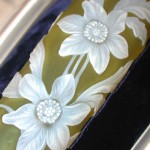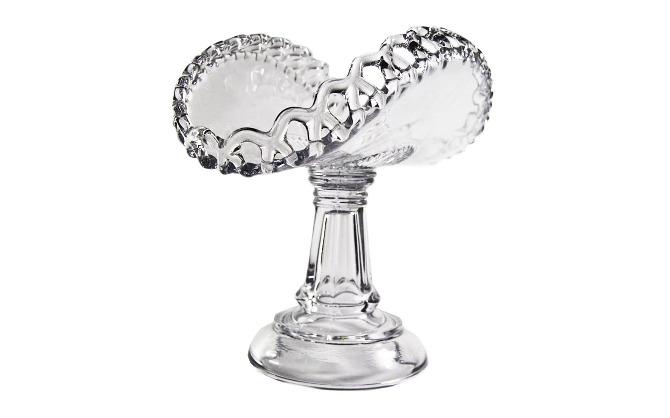To understand the origins of English antique glass it is important to know the historical importance of a truly ‘antique’ glass artefact.
In 1787 the collection of the Duchess of Portland was offered for sale by auction. The sale included the Barberini Vase, which was excavated early in the 17th Century from a Roman sarcophagus under the direction of Pope Urban VIII, his family name being Barberini. The urn originally contained the ashes of the Roman emperor Alexander Severus and his mother and had been entombed circa AD 235.The vase is of a rich dark blue color almost black in depth, the figures cut in bas-relief into the white glass overlaid on the blue ground. It is believed that work was executed by craftsmen trained in Alexandria, Egypt where cameo glass manufacturing was first practised.
At the auction the Duke of Portland (son of the Duchess) and Josiah Wedgwood were the two main contenders for ownership. The auctioneer had reached £1,000 guineas when the Duke went to Wedgwood and asked him why Wedgwood wanted to own the vase. The potter replied that he wished to copy it. The Duke offered to loan the piece to Wedgwood if he would drop out of the bidding. Wedgwood agreed and the piece became the property of the Duke of Portland and was at once known as the Portland Vase.
 In1810 the vase was put on display at the British Museum. Many craftsmen attempted to copy it but it became revered as an example of ancient glassmaking that could not be reproduced today. On 7th February 1845 a fanatic smashed the vase into 189 pieces with a stone. The ‘stout young man’ was detained, arrested and taken to Bow Street police station, who gave his name as William Lloyd. He could offer no valid reason for damaging the work other than that he had ‘been indulging in intemperance for the week before’
In1810 the vase was put on display at the British Museum. Many craftsmen attempted to copy it but it became revered as an example of ancient glassmaking that could not be reproduced today. On 7th February 1845 a fanatic smashed the vase into 189 pieces with a stone. The ‘stout young man’ was detained, arrested and taken to Bow Street police station, who gave his name as William Lloyd. He could offer no valid reason for damaging the work other than that he had ‘been indulging in intemperance for the week before’
Owing to a lapse in the law the offender escaped with only a very slight punishment. So great a public outcry was there at this act of vandalism that the law was changed to make similar acts punishable by imprisonment. The pieces were skilfully joined. A marvel in itself. Benjamin Richardson seeing how much publicity the destruction of the vase had caused offered £1,000 prize for the first accurate glass copy of the Portland Vase in 1860.
It was not until 1876 that Phillip Pargeter the owner of the Red House Glass works felt his glass workers had the skill to reproduce a blank in the form of the Portland Vase. Pargeter asked John Northwood I (1837-1902) if he would carry out the carving.
The carving took 3 years to complete and the vase caused a sensation. The vogue for cameo glass was set in motion.
The Making of Cameo Glass
Pergeter and Northwood had no knowledge of how the Romans had produced such a vase. They adapted techniques already in existence in the English Glass making areas.
The cameo blank was produced by adapting the technique of ‘cased’ glass introduced to England in the 1840’s. To make a suitable blank it was found that both the colours had to be physically compatible with virtually identical coefficients of expansion and contraction. The white outer layer of glass is formed first, the colour being blown into the outer layer rather than the white being applied to the colour. The glass is then repeatedly heated and formed into the desired shape. The more complex the form the greater the likely-hood of the join between the two colours failing resulting in the glass fracturing during cutting.
Northwood may not have been familiar with Roman techniques but he had extensive knowledge of etching and relief carving. Acid etching was of importance to cameo production as it allowed large areas of ‘unwanted’ outer layer glass to be removed relatively quickly rather than painstakingly removing it by hand. The carving of the design is achieved in two ways. Firstly the outer layer is roughened by acid pitting to provided a key for the acid resist. The pattern is then painted in acid resist and repeatedly placed in hydrofluoric acid which removes any area not covered by the resist. The remaining glass is then modelled using small steel points set into wooden holders to ‘carve’ the glass.
Within a year of Northwood completing his Portland Vase all the major Stourbridge factories were producing cameo glass to capitalise on the publics’ interest in cameo glass and their desire to possess a piece of craftsmanship of such skill. Notable producers of English Cameo glass are Stevens & Williams Richardsons and Thomas Webb
In 1887 the firm of Stuart Crystal patented the idea of ‘Medallion Cameo’, described in the Pottery Gazette as
‘the latest Art production for this season, a most delicate and entirely novel effect in Vases, Bowls and Scent Bottles’

Fuchsia.
A Stuart ‘medallion cameo’ Scent Bottle,
two colour cameo on crystal, cut with fuchsia and a butterfly,
Information and images – Andrew Lineham Fine Glass

















